The parable of the blind men and the elephant is used to illustrate how inacurate perception can be, how biases can blind us, and how the entire truth of something might be misunderstood despite accurate observation. Naturally, this can cause a lack of clarity, and also cause conflict. This parable is often used as a cautionary tale against the adoption or promotion of “absolute truths”.
The story of the blind men is probably the most widely known of the Buddhist parables. It originated in India (in the Pali Buddhist Udana) and spread across the world. By far the earliest version of it is to be found in the Udana, one of the books of the Buddhist scriptures where it is attributed to the Buddha (Ud.67-9).
This story was made famous by Rumi (Jalal ud-din-i Rumi 1207-1273 c.e.), the great Sufi master, in his Mathnawi of Jalalu’ ddin Rumi, the parable has been used to illustrate a range of truths and fallacies.
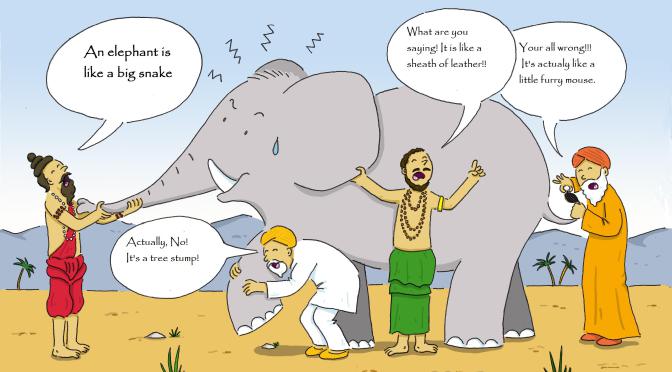
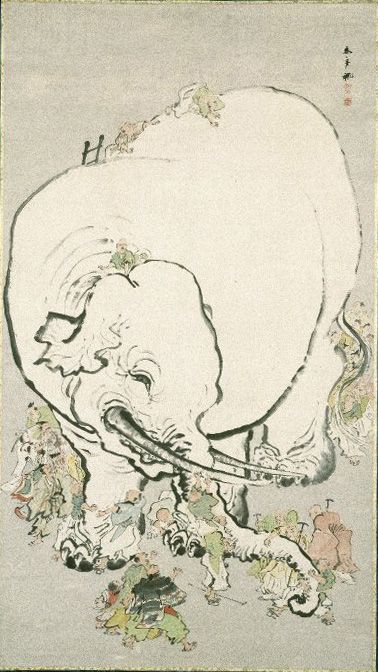
Artist: Ohara Donshu\ Title: Blind Men Appraising an Elephant Date:between 1800 and 1850 Medium: ink and colors on paper
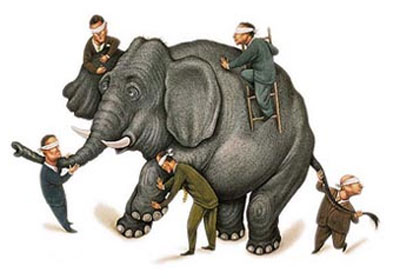
A modern drawing with men in suits
The background to the Buddha telling this parable goes like this. Some monks in Savatthi noticed a group of non-Buddhist monks quarrelling with each other about some philosophical or theological issues. Later, they mentioned what they had seen to the Buddha and he said: “Wanderers of other sects are blind and unseeing. They don’t know the good and the bad and they don’t know the true and the false. Consequently they are always quarrelling, arguing and fighting, wounding each other with the weapon of the tongue.” Then the Buddha related his famous parable:
“Once here in Savatthi, the king called a certain man and said ‘Assemble together in one place all the men in Savatthi who were born blind.’
Having done as the king commanded, the king then said to the man ‘Now show the blind men an elephant.’
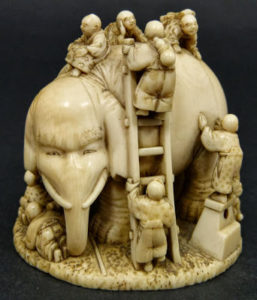
Again the man did as the king commanded, saying to each as he did ‘Oh blind man, this is an elephant and this is its head. This is its ear. This is its tusk. This is its trunk. This is its body. This is its leg. This is its back. This is its tail. This is the end of its tail.’
This having been done the king addresses the blind men saying ‘Have you seen an elephant?’ and they replied ‘We have sire.’
‘And what is an elephant like?’ he asked.
And the one who had touched the head said ‘An elephant is like a pot.’
while the one who had touched the ear said ‘An elephant is like a winnowing basket.’
The one who had touched the tusk said ‘An elephant is like a plough pole’
while the one who had touched the trunk said ‘It is like a plough.’
The one who had touched the body said ‘It is like a granary’
and the one who had touched the leg said ‘It is like a pillar.’
The one who had touched the back said ‘It is like a mortar’,
the one who had touched the tail said ‘It is like a pestle’
while the one who had touched the end of the tail said ‘An elephant is like a broom.’
Then they began to quarrel saying ‘Yes it is!’ No it isn’t! An elephant is like this!’ ‘An elephant is like that!’, until eventually they began fighting with each other.”
Having told this story the Buddha summed up its meaning in a terse little verse –
“Some monks and priests are attached to their views
And having seized hold of them they wrangle, like those who see only one side of a thing.”
from: www.ancient-buddhist-texts.net/Texts-and-Translations/Udana/6-Jaccandhavaggo-04.htm
The meaning of the parable is illuminated in the last line of this verse; seeing only one side of a thing (ekanga dassino). This is but one example of where the Buddha gives advice about how to form a more complete, a more accurate view of reality.
In other words, we should not mistake the part for the whole.
The Buddha also, in another script, offers very insightful advice when he advises one to keep personal biases out of the way when assessing views, taking time to form an opinion, and once an opinion is formed, to keep an open mind so as to be able to consider fresh evidence. Very sensible advice, applicable to conflict resolution.
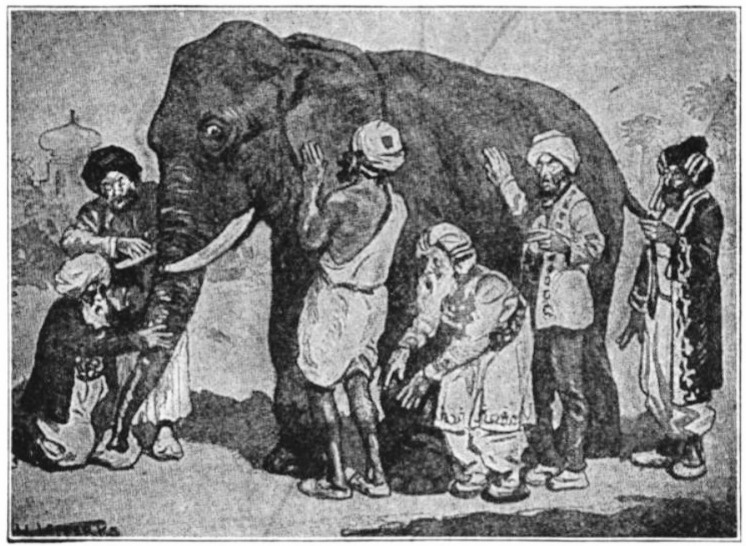
There are many versions of the parable and differences are mainly in the number of men, and what body part is being touched and described. These blind men, blind villagers, blind monks, or blind sages signify “people in the dark“, people who lack a full view, or insight into the entirety of a “thing”. In these stories, each man feels a different part of the elephant, but only that one part, such as the tail or the trunk. They then compare notes and learn that they are in complete disagreement.
~~~
Here is a modern version of this story as it appeared later by Rumi .. rephrased:
A long time ago and in a distant village, there lived six blind men (the original was said to have 10 blind men). One day the villagers announced, “there is an elephant in the village today! It lays to sleep by the fountain this moment!” These blind villagers had never seen, smelled, or felt an elephant before. They were very curious so they rushed to go and touch this elephant.
And thus they went down to the village to touch and feel the elephant to learn what kind of creature it is. As each man went their own way, and touched a separate part of the animal, they proclaimed:
“Hey, an elephant is a pillar,” said the first man as he was examining a leg.
Another man, who was carefully sensing the tail proclaimed: “Oh, no! it is like a rope,” (and he probably added some words I will not write here as he thought the other man was incorrect)
The first man screamed saying “No, no, no! it is like a thick branch of a tree,” as he hung on the elephant’s trunk.
The forth said “You are all wrong, fools, an elephant is a big hand fan made of leather”
The fifth blind man, very confidently proclaimed that his peers must be ill, and he said “You are all wrong, what foolishness do you utter, the elephant is a huge wall,” as he was touching the vastness of the elephants belly.
The final blind man confused, said to the others it is long like you said, but far from being a broom or a tree trunk, and certainly it is not a wall, it is in fact a long solid sharp spear!” Said the sixth man with the tusk in his hand.
Naturally, they all continued to argue, each holding their ground and their own perception as the only reality.
A wise sage happened to hear the argument, stopped and asked them “What is the matter?” They said, “We cannot agree to what the elephant is like.” The wise man, who happend to be able to see, calmly said, “Each one of you is correct; and each one of you is wrong.”
He continued, each of you only had a partial view of the animal. If you put your partial views together, you will get an idea of what an elephant looks like.
~~~
Imagine an airplane instead!
Here’s the Ethan Wise adaptation of this story:
If i said this story today, I would replace the elephant with an airplane which travels back in time to a culture that does not know airplanes, and bring 10 bind men to this sleeping (parked) airplane, these men also can’t hear or smell; have each of them describe a part of the airplane; being a completely alien “thing” these men would have a heck of a time agreeing on what they felt with their hands!
How often are we blind to the full picture?
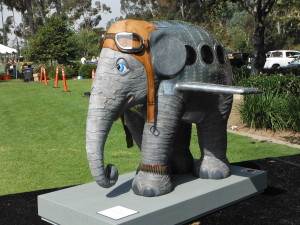

A modern flying elephant?
~~~
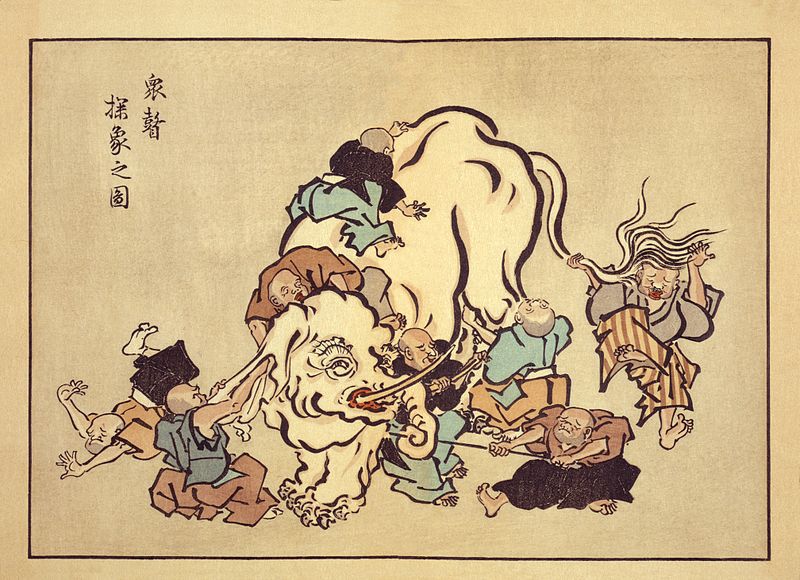
“Blind monks examining an elephant” by Itcho Hanabusa 1888
Although the parable’s function is to call attention to a lack of objectivity and consideration of other approaches and perspectives when trying to understand the nature of things, we do have to warn that not all perspectives are equally valid, and even valid arguments are not necessarily equally sound.
One can argue that every single thought and emotion we have, are mere opinions and perceptions, very unique to our own inner individualized self. Each of us lives in our own world, with our own past life experiences and sensory perceptions, biases, programming, fears, lessons, etc..
The good news here is that we also have the power to change our perceptions. This is where hypnosis becomes very helpful.
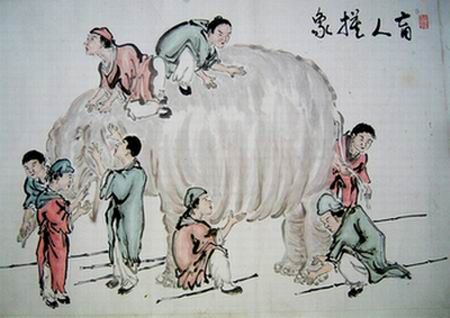
“This famous story is not actually an “original” Chinese story. It was recorded in a Buddhism canon (涅槃经), so it is probably from India. Anyway, since it is now an important Chengyu (Chinese idiom) with a philosophical inspiration, I decide to put it here.” Source URL: chinablog.cc/… Image URL: blind_men_and_elephant.jpg (450×318)
~~~
The elephant represents a reality of a certain situation, or some absolute reality. Each of the worthy blind sages represents a different approach to understanding this reality. In all objectivity, and in line with the poem of John Godfrey Sax, all the sages have correctly described their piece of reality, but fail by arguing that their reality is the only truth.
And so these men of Hindustan
Disputed loud and long,
Each in his own opinion
Exceeding stiff and strong,
Though each was partly in the right
And all were in the wrong.John Godfrey Saxe
Unless we can piece together the realities of the sages we can in no way be objective and we will fail to understand the whole elephant.
How can anyone describe the whole until he has learned the total of the parts.
~~~
The blind men and an elephant by John Godfrey Saxe (1816-1887)
It was six men of Indostan
To learning much inclined,
Who went to see the Elephant
(Though all of them were blind),
That each by observation
Might satisfy his mind.
The First approached the Elephant,
And happening to fall
Against his broad and sturdy side,
At once began to bawl:
“God bless me! but the Elephant
Is very like a WALL!”
The Second, feeling of the tusk,
Cried, “Ho, what have we here,
So very round and smooth and sharp?
To me ’tis mighty clear
This wonder of an Elephant
Is very like a SPEAR!”
The Third approached the animal,
And happening to take
The squirming trunk within his hands,
Thus boldly up and spake:
“I see,” quoth he, “the Elephant
Is very like a SNAKE!”
The Fourth reached out an eager hand,
And felt about the knee
“What most this wondrous beast is like
Is mighty plain,” quoth he:
“‘Tis clear enough the Elephant
Is very like a TREE!”
The Fifth, who chanced to touch the ear,
Said: “E’en the blindest man
Can tell what this resembles most;
Deny the fact who can,
This marvel of an Elephant
Is very like a FAN!”
The Sixth no sooner had begun
About the beast to grope,
Than seizing on the swinging tail
That fell within his scope,
“I see,” quoth he, “the Elephant
Is very like a ROPE!”
And so these men of Indostan
Disputed loud and long,
Each in his own opinion
Exceeding stiff and strong,
Though each was partly in the right,
And all were in the wrong.
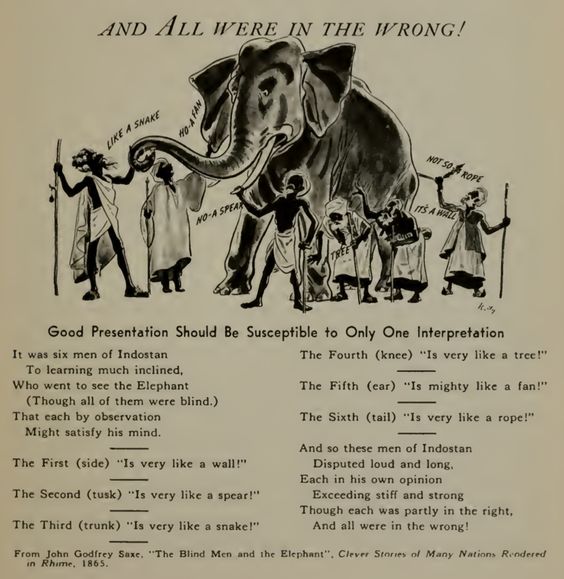
“And All Were in the Wrong!” This graphic is from the book Graphic Presentation written by Willard C. Brinton in 1939. The original story is “The Blind Men and the Elephant” by John Godfrey Saxe. Source URL: www.idea-sandbox….
In our modern world (even in times long passed), we are often presented by the outside world, and sometimes by our inner world with two sides to reality: black or white: good or bad; ethical or unethical, right or wrong.. We are asked or expected to take sides by others, or by our own inner ego. At such times, it can be helpful to remember this parable.